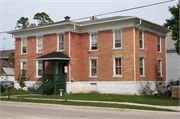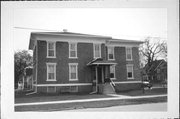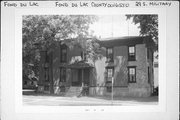Property Record
29 S MILITARY RD
Architecture and History Inventory
| Historic Name: | MERRILLE INSTITUTE |
|---|---|
| Other Name: | |
| Contributing: | |
| Reference Number: | 16550 |
| Location (Address): | 29 S MILITARY RD |
|---|---|
| County: | Fond du Lac |
| City: | Fond du Lac |
| Township/Village: | |
| Unincorporated Community: | |
| Town: | |
| Range: | |
| Direction: | |
| Section: | |
| Quarter Section: | |
| Quarter/Quarter Section: |
| Year Built: | 1868 |
|---|---|
| Additions: | |
| Survey Date: | 2010 |
| Historic Use: | school-one to six room |
| Architectural Style: | Italianate |
| Structural System: | |
| Wall Material: | Brick |
| Architect: | |
| Other Buildings On Site: | |
| Demolished?: | No |
| Demolished Date: |
| National/State Register Listing Name: | Not listed |
|---|---|
| National Register Listing Date: | |
| State Register Listing Date: |
| Additional Information: | 1988: This two-story Italianate house has a hip roof with wide eaves and a wide frieze. The building is constructed of brick and has regular fenestration of sash windows decorated with lintels. A small, later-added overhang covers the main entrance. This building was constructed for Matilda Merrille's private school. Merrille was a college graduate who taught in Fond du Lac in the high school program. She was briefly on the faculty of the University of Wisconsin in Madison, then in 1868 she had this building constructed for her school. Curriculum was like that in the public schools with additional courses in language and music. The school was in operation until the 1880s. Around 1900 the building was converted to apartments. There were many short-lived private schools in communities all over the state, especially prior to the establishment of public high school programs. Fond du Lac has a number of private schools in the nineteenth century, but this school was the most successful, other than the church schools established in the city. 2010-2011 Intensive Survey Report Info: Italianate in style, this two-story, hipped-roof, two-block, brick structure features overhanging eaves with a coved wooden cornice. The north block of the building includes the primary entrance which is sheltered by an open, hipped-roof porch with simple wooden porch posts and balustrade. Windows throughout the entire structure are two-over-two-light, double-hung sashes with modest lintels and sills. This structure was built in 1868 as the Merrille Institute, an elite school for girls begun two years prior by Matilda S. Merrille. Merrille was born in Bethel, Maine, in 1829 and was educated at Syracuse University. After first teaching in the Sheboygan County schools, she came to Fond du Lac in 1855. She and Edwin Johnson are identified as the first teachers in Fond du Lac's first high school, which opened in 1859. She left Fond du Lac for a short time and is noted as the second female to serve on the faculty at the University of Wisconsin-Madison. In 1866, however, she returned to Fond du Lac and opened her privately run high school-level facility in her own home on Division Street. Tuition was cited as $10 per 13-week term, with a school year planned to consist of three such terms. Merrille's school was at capacity by the end of the first term. On 26 February 1868, Miss Merrille purchased the subject lot for $1,500 and built the subject building the same year. William Bensel is identified as the carpenter/builder of the structure. The new facility had a capacity of 90 pupils and offered the same curriculum as the public school, along with French and music. By 1880, the school was no longer directed by Miss Merrille and was, instead, run by #28;the Misses Martin.#29; The school's success seems to have dwindled thereafter, for in 1884, the graduating class numbered just three. In 1887, it was announced in the local paper that the fourth and last classroom of the school was being cleared and refitted for residential purposes and the school was discontinued. Miss Merrille retained ownership of the building until 1899, after which it was formally converted for residential use and identified as the Merrille Flats. It was advertised in June 1900 as consisting of two, six-room suites and two, seven-room suites with steam heat, electricity, modern kitchens and speaking tubes. They were cited as "the first flat ever instituted in the city," and remodeling work was undertaken by P.B. Haber, F. B. Hoskins and S.D. Wyatt. The building continues to serve as apartments and was designated as a local landmark in 1973. Better examples of the Italianate style exist within the city. The structure is significant for its association with Fond du Lac's educational history. Although its Period of Significance is somewhat brief (1868 to 1887), the structure stands as a testament to the establishment of nineteenth century private schools. |
|---|---|
| Bibliographic References: | (A) FOND DU LAC TALKING HOUSES AND HISTORIC PLACES BROCHURE, FOND DU LAC CONVENTION AND VISITORS BUREAU. (B) FOND DU LAC CITY DIRECTORIES. (C) SANBORN-PERRIS MAPS - FOND DU LAC. (D) FOND DU LAC TAX ROLLS. L.J. Niedfeldt, "Area's Elite Girls Once Looked to Merille Institute," Action Sunday, 2 February 1992, 1. History of Northern Wisconsin (Chicago: Western Historical Company, 1881), 879. See 2010-2011 Intensive Survey Report for additional citations for material below. |
| Wisconsin Architecture and History Inventory, State Historic Preservation Office, Wisconsin Historical Society, Madison, Wisconsin |



